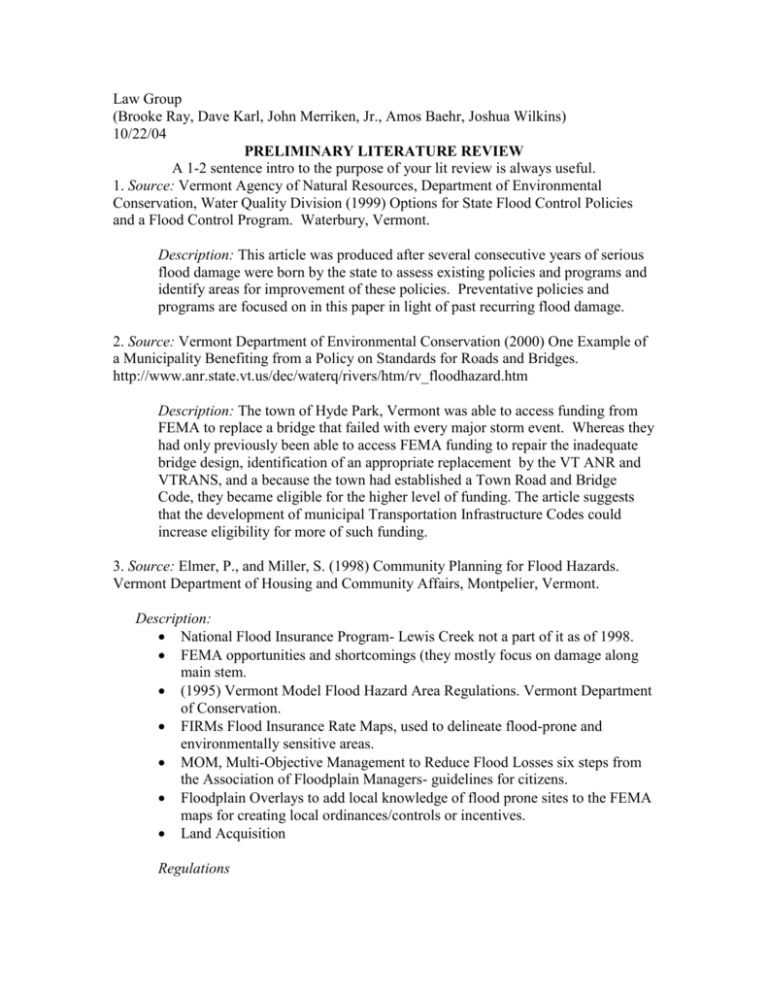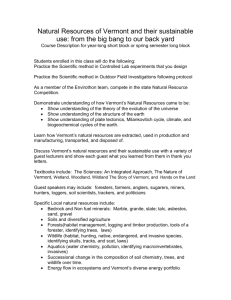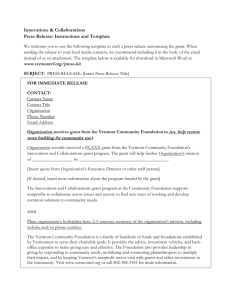Vermont Agency of Natural Resources, Department of
advertisement

Law Group (Brooke Ray, Dave Karl, John Merriken, Jr., Amos Baehr, Joshua Wilkins) 10/22/04 PRELIMINARY LITERATURE REVIEW A 1-2 sentence intro to the purpose of your lit review is always useful. 1. Source: Vermont Agency of Natural Resources, Department of Environmental Conservation, Water Quality Division (1999) Options for State Flood Control Policies and a Flood Control Program. Waterbury, Vermont. Description: This article was produced after several consecutive years of serious flood damage were born by the state to assess existing policies and programs and identify areas for improvement of these policies. Preventative policies and programs are focused on in this paper in light of past recurring flood damage. 2. Source: Vermont Department of Environmental Conservation (2000) One Example of a Municipality Benefiting from a Policy on Standards for Roads and Bridges. http://www.anr.state.vt.us/dec/waterq/rivers/htm/rv_floodhazard.htm Description: The town of Hyde Park, Vermont was able to access funding from FEMA to replace a bridge that failed with every major storm event. Whereas they had only previously been able to access FEMA funding to repair the inadequate bridge design, identification of an appropriate replacement by the VT ANR and VTRANS, and a because the town had established a Town Road and Bridge Code, they became eligible for the higher level of funding. The article suggests that the development of municipal Transportation Infrastructure Codes could increase eligibility for more of such funding. 3. Source: Elmer, P., and Miller, S. (1998) Community Planning for Flood Hazards. Vermont Department of Housing and Community Affairs, Montpelier, Vermont. Description: National Flood Insurance Program- Lewis Creek not a part of it as of 1998. FEMA opportunities and shortcomings (they mostly focus on damage along main stem. (1995) Vermont Model Flood Hazard Area Regulations. Vermont Department of Conservation. FIRMs Flood Insurance Rate Maps, used to delineate flood-prone and environmentally sensitive areas. MOM, Multi-Objective Management to Reduce Flood Losses six steps from the Association of Floodplain Managers- guidelines for citizens. Floodplain Overlays to add local knowledge of flood prone sites to the FEMA maps for creating local ordinances/controls or incentives. Land Acquisition Regulations Look for overlay zoning districts for controls and incentives in sensitive areas and known and established floodplains. Requiring conditional use permits that would have to be reviewed by the Zoning Board of Adjustment. Example North Hero. Strategies for restricting development in flood prone areas and examples. Regulations meant to protect private property from flood damages. Extend to zoning and development only in flood zones. Preventative of flood damage, not so much flood-planning. 4. Source: VPIRG Website, retrieved 10/27/04 http://www.vpirg.org/campaigns/environmentalHealth/stormwater_factsheet.html Description: Point Source Pollution permits have expired and gone un-enforced allowing pollution to continue. (for Stormwater runoff) 5. Road Design and Maintenance Handbook: Techniques for Reducing Flood Damage to Local Roads. Vermont Local Roads Program, St. Michaels College, Colchester, Vermont 6. Administration of Floodplain Management By-Laws: A Handbook for Local Officials. Vermont Department of Environmental Conservation, Waterbury, Vermont. 7. FEMA Community Rating System: A Comprehensive Approach to Floodplain Management. The City of Tallahassee Stormwater Utility Floodplain Management. 8. The Flood Control Districts Webpage. Gary G. Peterson, Principle Planner. Pima County Flood Control District. http://www.dot.co.pima.az.us/flood/ 9. 10 VSA Section 1021 Gravel Removal and Chapter 41 10. US Code Title 33, Clean Water Act Brief summaries of the relevant material from all of these would be helpful, even if it is just a sentence or two. 11. Source: The Vermont Institute for Government. (2000) The Law of Water: An Introduction to Vermont Water Law. Berlin, Vermont http://crs.uvm.edu/citizens/ Description: The article summarizes the classes for different bodies of water and the broad protections these classes enjoy. Enforcement: Army Corps of Engineers Stream Boundaries: Can’t change them, how deeds to property are worded matters. Water under the land you own is yours. Accretion, Avulsion, and Erosion: Slow accretion doesn’t require changes in deed or title, the land just passes from one owner to another. But flood changes may not changes boundaries in this way, even when the course of the stream is changed. Flowage: General boundaries on citizens and government for altering path and flow of rivers and streams. Lake Boundaries: Law of the Sea Springs: A town can condemn?? rights to water on public property in the public interest within its boundaries. Permitting: Says to check before any alterations to land or water are made: earth moving, relining ditches, filling them in, building a bridge over a stream, etc. Public Easements: 12. Source: State of Vermont Environmental Board. (2000) ACT 250: A Guide to Vermont’s Land Use Law. Montpelier, Vermont Description: Development Regulations and Review for Certain Types of Development in Vermont. LCW is Addison in District 9, Essex Junction Office, phone # 879-5614 Criterion 1: Water and Air Pollution 1a. Headwaters 1b. Waste Disposal 1c. Water Conservation 1d. Floodways: New development can’t restrict the flow of water or floodwater in floodplain or on its fringes. *Does Act 250 use the FEMA FIRM maps to identify floodplains? Can a town’s mapping be added to the sensitive areas? Also, can’t significantly increase the peak water discharge into streams and rivers within or downstream of development. 1e. Streams: Must maintain “natural state” of the stream and not harm landowners or the public. 1f. Shorelines: Must prove necessary to be there, and must maintain integrity of shore. Can’t limit continued public access to that water. 1G. Wetlands Criterion 2: Water Supply must be adequately available for the development. Criterion 3: Impact on Existing Water Supply 13. Source: Vermont Statutes Online. (2004) TITLE 10: Conservation and Development, PART 2: Soil and Water Conservation; Flood Control, CHAPTER 37: WATER RESOURCES MANAGEMENT. http://www.leg.state.vt.us/statutes/statutes2.htm Description: Chapter 37 of Title 10. Water Resources Board DEC Investigators employed by the DEC have certain rights over sections of Title 10 to enforce them. Entrance upon lands for inspection allowed Temporary Emergency Powers Aquatic Nuisance Control- includes sediment deposition, the state shall maintain a program for this purpose § 922: Grant-in-Aid to Municipalities and Agencies of the State- priorities and criteria for distribution of available monies for Aquatic Nuisance treatment and Prevention. Joint Municipal Participation Office of the Secretary of State: Has most up to date laws available. Act 137 Section2 Vermont Water Resources Board www.state.vt.us/wtrboard/related_links.htm - 15k Check out From Rooftop to River: Tulsa’s Approach to Floodplain and Storm water Management. The City of Tulsa Oklahoma. Lit review; amos baehr Source: The Legal Aspects of Owning and Managing Woodlands The bulk of the book addresses the rights of property owners with respect to timber sales and the responsibility of government to regulate those sales with respect to the rights of adjacent landowners and the public in general. This part of the book is not applicable to water because in general a landowner does not own the water passing over his property. Basic property rights include the use of water as a fund service but not as a stock flow commodity. However, many landowners and conservation groups wish to maintain woodlands as woodlands for economic, cultural and personal reasons and this book outlines a number of strategies to do so. It discusses in principle, property rights and the sale and gifting of portions of those rights (ie. Development rights) and frequently suggests professional consultation with an accountant and real estate attorney. The transfer of property to heirs or purchasers with the express intent of preserving woodlands is parallel to the transfer of riparian rights and this portion of the book is highly applicable to The LCA situation. My understanding is that Marty wants you to imitate the format of the book. I don’t think that she was claiming the content is directly relevant. Source: Corpus Juris Secundum This is an encyclopedic treatment of the law that provides an orientation to the general position of the law with case references. It does gives some sense of the breadth of variation among the states but does not attempt a detailed description of conditions within the states. Entries include a concise abstract, a footnoted expansion of several paragraphs, case identifications corresponding to the footnotes. I found it very helpful in identifying those issues which are customarily dealt with in the courts what legal precedents determine the general attitude of the courts. Water law varies so much between regions in the US that it might be more useful to find books that focus only on Vermont or New England (I think Vermont law is similar to New England’s, but I know eastern water law is very different than western, and there is considerable state to state variation as well). When reading in the section on waters ( 327 entries covering nearly 800 pages) I found frequent reference to “common law” and so read concerning the nature of the common law. There was also repeated reference to courts of equity much of which was obscure to me but this statement stands out, “Equity will act to prevent the imposition on one person of a burden which ought to be borne in common.” Interesting that equity only refers to burdens. This implies the state is entitled to provide benefits to any individual, i.e. transfer the assets of the commonwealth from the many to the few. Relevant sections included under Waters I. Nature, ownership, and classification ( 2 entries) II. Natural watercourses (187 entries) A. In general (6 entries) B. Riparian rights in general (9 entries) 10. Power to control or regulate water courses 12. Right to natural flow C. Obstruction and Detention; flooding and flowage (73 entries) 28. Embankments, levees, and other works to protect property 29. Embankments, levees, and other works to protect property – floods 30. Bridges, railroad embankments, and other works 31. Bridges, railroad embankments, and other works – care and skill in construction 32.Bridges, railroad embankments, and other works – extraordinary rains and floods D. Deepening Natural Channels (2 entries) G. Beds and banks of stream (20 entries) 170. Ownership of bed of stream 171. Ownership of bed of stream – Effect of meander line 174. Ownership of banks of stream 176. Reclamation and improvement 178. Accretion and alluvium – division of land formed by accretion 184. Erosion 188. Conveyances and contracts – Public grants V. Surface waters (43 entries) B. Natural flow or drainage and obstruction thereof (9 entries) 1.General 259. Easement for surface water to flow naturally 2.Surface water as common enemy (3 entries) 3. Construction and maintenance of railroads (3 entries) D. Creation and transfer of right of easement or right of drainage (4 entries) VI. Artificial Watercourses, conduits, ponds, and other works (31 entries) A. Artificial canals, ditches, and channels 1. Nature and rights 299. Persons have rights in artificial watercourses 3. Injuries by breakage, leakage, overflow, or seepage 306. Injuries from changing course of stream Comments: In general the law reflects several hundred years of ignorance about intervention in the natural course of a stream. The fact that there is a legal doctrine applied in some jurisdictions under the title of “surface waters as common enemy” indicative of the general tone of the law in support of riparian owner rights to direct and accelerate the drainage of surface waters from their property. The law does acknowledge that this can injure other riparian owners and the public and requires reasonableness in use and liability for damages. But historically the kinds of channel manipulation and bank stabilization that we now know as problematic are considered reasonable and are sometimes expressly permitted by law. I wonder how much prior manipulations were responsible for making surface water the enemy. If much channelization occurred 150 years ago, by the time these laws were passed, it may have become ‘an enemy’. Of particular interest was a principal prohibiting anyone, including the state, from introducing obstructions that might slow the rapid flow of water from a person’s property. I saw in this a potential legal challenge to some of the active and passive strategies proposed by Mike Kline. I repeat that this source is not specific to Vermont but even if Vermont has passed more progressive law it is certain that attitudes of some stake holders will be closer to the historical perspective voiced in the Corpus Juris Secundum. I will comment more hopefully on the general principals of common law that could form a basis is law for better inform action in the watershed and in the Legislature. Many of the rights of riparian owners are derived from the English common law which is defined by Blackstone as that law based not on legislative action but on immemorial usage and the general consent of the people. The common law does not consist of definite rules which are absolute, fixed, and immutable like the statute law, but it is a flexible body of principals which are designed to meet, and are susceptible to adaptation to …increasing knowledge as the progress of society may require Is this a quote? If so, where are the quotation marks? If not, why the ellipse?. The Corpus Juris Secundum is not a comprehensive source of common law principles but I shall list those I found most relevant. While statutory law over the last two centuries has favored straightening and draining stream courses, the common law might guide debate in a direction consistent with new knowledge and acceptable to a wide range of stake holders. The good or safety of the people is the supreme law The law delights to do justice and not by halves The law does not award consolation prizes A man’s home is his castle The end does not justify the means Actions speak louder than words A person will not be allowed to do indirectly what can not be done directly Public policy demands an end to litigation It is the policy of the law to favor the diligent and aid the vigilant Ignorance of the law excuses no one No legal wrong is done to one who consents It is evidence of the nature of the common law that several of these sayings are common grade school proverbs not generally thought of as having the weight of law. There are dozens of these maxims that have been established over centuries of practice. I have only scratched the surface but I conclude with this common law principle as a pertinent reminder,” fundamental principle cannot be set aside to meet the demands of convenience or to prevent apparent hardship in a particular case”. Is this a quote? If so, include the page number. You have some very good material here, though I get the feeling that not everyone participated in this. Also, it is essential to have references in the proper style. That means publisher, date, etc. In my lower level classes, I explicitly tell students they fail the assignment without proper references. In upper level classes, I don’t expect anyone to need a reminder.





